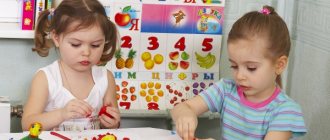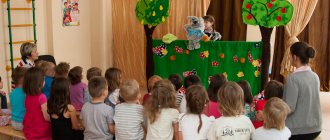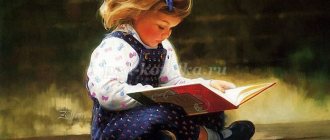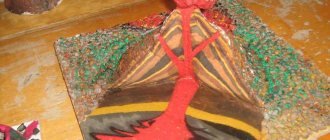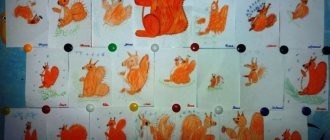Summary of leisure activities for older preschoolers with special needs “Maslenitsa has come!”
As a practicing speech therapist, I understand that the more extensive and varied the active vocabulary of a preschooler with SLD, the greater the base on which grammatical structures and coherent speech are formed. Therefore, the use of lexical material on the theme “Maslenitsa” will not only introduce children to folk culture and customs, but will also help solve purely speech therapy problems, reviving the pedagogical process. Goals:
Introduce children to the history and traditions of the Russian holiday - Maslenitsa.
Correctional and educational:
1. Develop the speech of preschoolers through exercises and game tasks related to the theme “Maslenitsa”.
2. Practice the formation of nouns in various case and prepositional case constructions.
3. Strengthen the skill of forming relative adjectives
4. Develop symbolic activity. Practice writing a story based on pictograms.
5. Update your vocabulary on the topic “Products”.
6. Practice forming related words.
Correctional and developmental:
Develop attention, thinking, visual perception. Develop speech, cognitive activity, fine motor skills.
Correctional and educational:
Revive interest in ritual Russian holidays. Foster a sense of patriotism based on Russian traditions.
Enrich the spiritual world of children. Summarize and consolidate children's knowledge about the Maslenitsa holiday. Introduce children to folk art and musical culture. Strengthen children's health using health-saving technologies.
Types of children's activities:
communicative, cognitive-research, gaming, productive, physical.
Preliminary work:
Conversation about Maslenitsa.
Equipment:
Subject pictures or on a presentation slide: Scarecrow, Maslenitsa scarecrow, garden scarecrow. Musical instruments: rattle, pipe, bell, spoons, tambourine, ruble, whistles. White massage balls. White rag balls - “snowballs”. Game “Horses” to determine the place of a sound in a word (Fig.). “Buffoon” cards, pencils. Hoop.
Progress of activities
Folk music is playing. Children enter a group (or hall).
1. Organizational moment.
Speech therapist.
Guys, today we have a guest. Now you can guess who it is.
Pictures are placed on the board or on a presentation slide: Scarecrow from the fairy tale “The Wizard of the Emerald City”, garden scarecrow, scarecrow of Maslenitsa.
Speech therapist.
This guest is NOT from a fairy tale, is NOT guarding a vegetable garden, is NOT dressed in men's clothes, but only in women's clothes. Who is this?
Children.
This is a scarecrow of Maslenitsa!
Speech therapist.
That's right, she came to visit! Why do you think? What holiday is it a symbol of?
Children.
It's Maslenitsa!
Speech therapist.
Yes indeed. What does this scarecrow mean?
Children.
This is a scarecrow of winter.
Speech therapist.
You're right. And today we will visit the Maslenitsa holiday. Why is the holiday called that? What word does the name resemble?
Children.
On the word "oil".
Speech therapist.
Yes, indeed, because it was on Maslenitsa that one was supposed to eat everything fatty and oily before fasting.
2. Selection of related words.
Speech therapist.
Choose a family of related words for the word “butter”.
Children.
Butter, butter, butter dish, butter churn, butter.
3. Formation of relative adjectives.
Speech therapist.
Let's look at Maslenitsa. (Children answer by forming relative adjectives).
Her head is made of clay, which means she is...(clay), her face is made of paper -...(paper), her hair is made of straw, which means she is...(straw), her hands are made of reeds -...(reed), her scarf is made of calico.... (calico), linen shirt -...(linen), wool skirt -...(woolen), silk ribbon -...(silk), cardboard beads -... (cardboard), wooden stand -... (wooden).
Speech therapist.
Well done!
Further, in the process of activity, the speech therapist puts presentation slides with supporting pictogram symbols on the board or on the screen of the media system, based on which the children compose a story about Maslenitsa. (see Appendix No. 1)
4. Psycho-gymnastics.
Speech therapist.
Guys, do you remember when this holiday comes?
Children.
Yes, when winter leaves and spring comes. (Look at the corresponding pictogram)
Speech therapist.
Imagine that the sun has warmed up. Smells like spring. Breathe in the fresh air through your nose. (Children inhale through their nose and exhale through their mouth.) Snow is melting. Imagine a snowman melting. What he becomes. Picture it.
5. Work using pictograms.
Speech therapist.
So, how many days did Maslenitsa last?
Children.
Maslenitsa was celebrated for 7 days, and each day had a different name. (Look at the corresponding pictogram)
Children name the memorable names of the days of the holiday.
6. Formation of the instrumental case. (Look at the corresponding pictogram)
Speech therapist.
How did they celebrate Maslenitsa, what kind of treat?
Children.
They celebrated with pancakes, pies, bagels, rolls, cheese, butter...
Speech therapist.
What did you bring to visit?
Children list the treats using the preposition C.
Children.
We went on a visit with pies, with...
7. Self-massage with spiked balls - “snowballs”.
Speech therapist.
During Maslenitsa, both adults and children had fun and played snowballs. Let's roll some snowballs and play.
Children are given massage balls and perform massage movements with their palms. You can have a fun game of rag snowballs.
8. “Snow Fortress.” Determining the number of syllables in a word.
Speech therapist.
Great, now you can build a snow fortress. But the fortress will not be easy, it is made of snowballs, which must be arranged in this way: the number of syllables in the name of the picture, the number of snowballs in the fortress.
Children are given object pictures, they count the syllables and place as many snowballs in the fortress as there are syllables in the name of the picture.
9. "Orchestra". Determining the number of syllables in a word.
Speech therapist.
What's a holiday without musicians? During Maslenitsa, people often gathered in a cheerful orchestra and played musical instruments. But we have an unusual orchestra. You must make a sound as many times as there are syllables in the word your neighbor says.
Children are given spoons, rattles, tambourines, bells and other instruments. They stand in a circle with instruments, say a word associated with Maslenitsa to their neighbor, and he makes as many sounds as the number of syllables he has counted.
1 child.
The word is "fun".
2nd child.
I hit the spoons three times, because... the word has three syllables (beats with spoons). And the word for you is “pancakes”.
3 child.
I will ring twice. Because the word has two syllables.
And then all the children complete the task. If someone couldn't come up with a word, the others help him.
10. “Horse riding.” Determining the place of a sound in a word.
Speech therapist.
On Maslenitsa, people rode horses. And now we're going for a ride.
The speech therapist distributes the game “Horses” (Fig. 2). Children determine the place of the sound in the word (the word is pronounced by a speech therapist) and place the horses in the place on the sound line where the sound is located, i.e. at the beginning, middle or end of the track.
11. Plastic sketch “Strongmen”.
Speech therapist.
During Maslenitsa, men had a competition to see who was stronger. Picture yourself lifting heavy weights.
Children, together with a speech therapist, pretend to lift heavy weights. First, they tense their arm, lift it up, simulating a lifted weight, and then relax it and lower it down.
12. "Buffoon".
Speech therapist.
And now we have been invited to the booth by a cheerful buffoon. After all, on Maslenitsa people like to watch a funny performance and laugh. He wants to play such a fun game with you. (Figure 3)
Children are given colored pencils and cards.
Rice. 3.
Speech therapist.
Trace the drawing with dots. Who got it?
Children.
Buffoon.
12. "Jumping over the fire."
Speech therapist.
On the last day of Maslenitsa week, the ritual of seeing off Maslenitsa took place, which involved burning an effigy of Maslenitsa. But first they arranged jumping over the fire. Let's jump too!
Children jump through a hoop lying on the floor.
13. A story about Maslenitsa based on supporting pictogram diagrams.
Speech therapist.
And now we can talk about the holiday.
Children tell stories using pictograms. See Appendix No. 2
1. What time of year does it happen (late winter and early spring).
2. How many days are they celebrating?
3. What they bake.
4. Who is the main guest of Maslenitsa.
5. How people have fun during Maslenitsa.
— They go to visit with pancakes.
— They ride down the mountains, play in the snow, build snow forts, have fun in booths.
- They ride horses.
- They jump over the fire.
— At the end of the holiday, an effigy of Maslenitsa is burned.
13. Productive activity. Making hand-rolled dolls.
Speech therapist.
Guys, even on Maslenitsa they made special rolling dolls from pieces of paper, pieces of fabric, and waste material. They dressed them more beautifully, brighter, so that the evil disease would definitely like the doll. It was believed that if you burn such a small doll, or even several, then all illnesses and troubles will leave the house. Let's make these dolls too, and you can burn them on the street with your parents.
Children complete the task. A small piece of paper is rolled into a roll. A triangular “handkerchief” made of a cloth or piece of paper is tied on top of the roll. A cloth or piece of paper is also wrapped around the “body” and tied with a thread on the “belt”.
14. Surprise moment.
Speech therapist.
Well done, we had a lot of fun and talked about Maslenitsa. And now it's time to relax!
Children are treated to pancakes.
Bibliography.
1. Aleshina N.V. Familiarization of preschoolers with the environment and social reality. Preparatory group. Lesson notes. - M.: UTs PERSPECTIVA, 2008.
2. Aleshina N.V. Familiarization of preschoolers with the environment and social reality. Senior group. Lesson notes. - M.: UTs PERSPECTIVA, 2009.
3. Lalaeva R.I., Serebryakova N.V. Correction of general speech underdevelopment in preschool children (formation of vocabulary and grammatical structure). St. Petersburg: SOYUZ, 1999.
4. Novikova E.V. Secrets of prepositions and cases. Visual and practical guide. - M.: Publishing House GNOM and D, 2007.
5. Where does the Motherland begin? (Work experience in patriotic education in preschool educational institutions)/Ed. L.A.Kondrykinskaya. - M.: TC Sfera, 2003.
6. Tkachenko T.A. We learn to speak correctly. System for correcting general speech underdevelopment in 6-year-old children. - M.: Publishing House GNOM and D, 2004.
